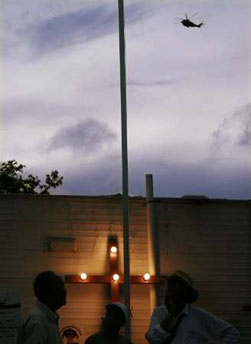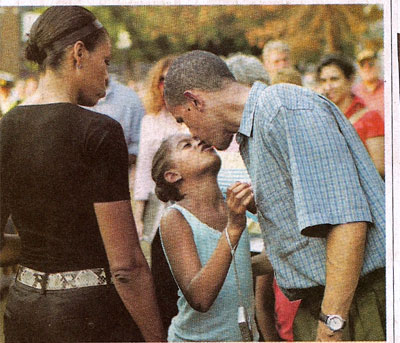Notes
Katrina At Two

On the second anniversary of the Katrina disaster, we are fortunate to have a photographer as talented as Louisianian, Lee Celano, supplying material for Reuters.
The anniversary presents a mandatory backdrop for a parade of political figures. Obama was prominent on the scene on Monday, and Alberto Gonzales was a big visual magnet yesterday, as was the arrival of Karl Rove. Of course, last night’s arrival of the President was the most ignominious.
As counterpoint, I offer you a shot by Celano that is circulating, hoping as many of his pictures as possible get picked up from the newswire.
The image above is a wonderfully “woven” play of two parts, evoking such tried-but-true metaphors as “the difference between day and night” and “being left in the dark.” Among the stew of elements, it collages: (a.) Lower Ninth Ward residents gathered near (b.) an illuminated crucifix, which is leaning against (c.) a (supposedly temporary) trailer, as (d.) George Bush’s (e.) helicopter fleet flies into New Orleans. (Since Katrina, Bush exclusively helicopters into disaster areas.)
Regarding the catch of the copter, it’s a clever way of cutting a PR mission off at the trail, this “pre-photo op” photo embodying the true orientation of Bush and the government to the reality on the ground, which stands out, as shown, as distant and peripheral.
I know Celano happens to like religious iconography. In this case, given the Administration’s full-court appropriation of Christianity and its symbolism (which the Katrina non-response stopped dead in its tracks), it is only fitting the cross — placed so informally, and crafted by hand — is absolutely situated within the community (and, in its centrality, offering the only source of illumination).
The fact the figures are in silhouette references another, if obvious point — that the largely poor and black population has remained mostly faceless to recovery. Less obviously, the shot creates an interesting twist on an observation photography blogger Joerg Colberg made in response to this week’s BAG post regarding the absence of people in recent magazine updates on New Orleans. Quoting an interview with photographer Simon Norfolk, Joerg writes:
Once you include people in a photograph, they “become what the photograph is.” …Thus, photographing the people who still suffer from the ongoing neglect and mismanagement would exclude those people from the picture – figuratively and literally speaking – who are responsible for that mismanagement (and vice versa).
In this case, managing to capture both the people who suffer and those responsible, and doing so with with abstraction and symbolism (juxtaposing the power on high with people in the community — while placing them closer to us and more discernible, but still obscured), Celano manages not just to grab hold of but amplify the human and political tension, with increasing dignity “toward the bottom.”
For related coverage of Katrina then and now, I direct you to this three-post series from last week featuring Alan Chin’s photographs from from FEMA’s Renaissance Trailer Park outside Baton Rouge, including: Renaissance Village From The Outside (8/16/07); Renaissance Clash (8/17/07); and Renaissance From The Inside (8/18/07). For Chin’s remarkable photos immediately after the hurricane, see And Then I Saw These (9/27/05) and St. Rita Ongoing (10/8/05).
(Here is the link to “Celano New Orleans” at YahooNews Photos for as long as it lasts. Lee Celano website here.)
(image: Lee Celano/Reuters. August 28, 2007. New Orleans. via YahooNews)


Reactions
Comments Powered by Disqus